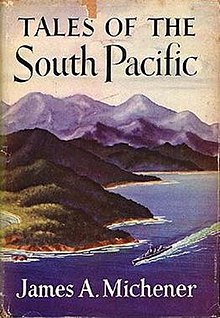Tales of the South Pacific
 First edition cover | |
| Author | James A. Michener |
|---|---|
| Language | English |
| Genre | Interrelated short stories |
| Publisher | Macmillan, New York |
Publication date | January 28, 1947 |
| Publication place | United States |
Tales of the South Pacific is a
Written in 1946 and published in 1947, the book was loosely adapted in 1949 as the Broadway musical South Pacific, which itself formed the basis of two films dating from 1958 and 2001.
Book
The stories take place in the environs of the Coral Sea and the Solomon Islands. Michener as narrator gives a first-person voice to several of the stories as an unnamed "Commander", performing duties similar to those that he himself performed during World War II. Two stories are narrated by a named Navy pilot.
The stories are interconnected by recurring characters and several loose plot lines. One plot line in particular is the preparation for and execution of a fictitious amphibious invasion, code-named "Alligator". The focus of the stories is, however, the interactions between Americans and a variety of colonial, immigrant, and indigenous characters.
The chronology of the stories begins with the building of an airfield on Norfolk Island before the Battle of the Coral Sea, in 1942, and goes through the early 1944 invasion of one of Michener's fictional islands. Although the stories are primarily about the U.S. Navy, most of the action is shore-based, and none of the stories concerns ships larger than a Landing Craft Infantry.
Structure
Tales of the South Pacific comprises nineteen stories, which are thematically linked in pairs: the first and final stories are reflective, the second and eighteenth involve battle, the third and seventeenth involve preparation for battle, and so on.
| 1. The South Pacific | 19. A Cemetery at Hoga Point |
| 2. Coral Sea | 18. The Landing on Kuralei |
| 3. Mutiny | 17. Frisco |
| 4. An Officer and a Gentleman | 16. The Strike |
| 5. The Cave | 15. Those Who Fratenize |
| 6. The Milk Run | 14. The Airstrip at Konora |
| 7. Alligator | 13. Wine for the Mess at Segi |
| 8. Our Heroine | 12. A Boar's Tooth |
| 9. Dry Rot | 11. Passion |
| 10. Fo' Dolla' | |
Recurring Characters
The following characters appear in more than 2 stories:
Tony Fry (Navy): Stories 3, 5, 12 and 13.
Bus Adams (Navy pilot): Stories 6, 13, 14 and 15.
Luther Billis (SeaBee): Stories 9, 12 and 14.
Adaptations
Musical
The highly successful musical play South Pacific by Rodgers and Hammerstein, which opened on Broadway on April 7, 1949, was based on the stories in Tales of the South Pacific. In particular, the stories used were "Fo' Dolla'", about Bloody Mary, Liat, and Lieutenant Joe Cable; and "Our Heroine", about Nellie Forbush and Emile de Becque. Characters from other stories, such as Bill Harbison, Bus Adams, and Luther Billis, play minor or supporting roles.
Some of the characters from the stories were merged and simplified to serve the format of the musical. For example, the
Films of the musical
The Rodgers and Hammerstein musical South Pacific was made into a
Television
American television producer Bob Mann wanted Michener to co-create a weekly television anthology series from Tales of the South Pacific, with Michener as narrator. Rodgers and Hammerstein, however, owned all dramatic rights to the novel and did not give up ownership.[1] Michener did lend his name as the creator of a different and unrelated television series, Adventures in Paradise, in 1959. The series had nothing to do with World War II, but rather followed the fictional adventures of a current-day schooner sailing around the South Pacific.[1]
See also
- Guadalcanal Campaign


